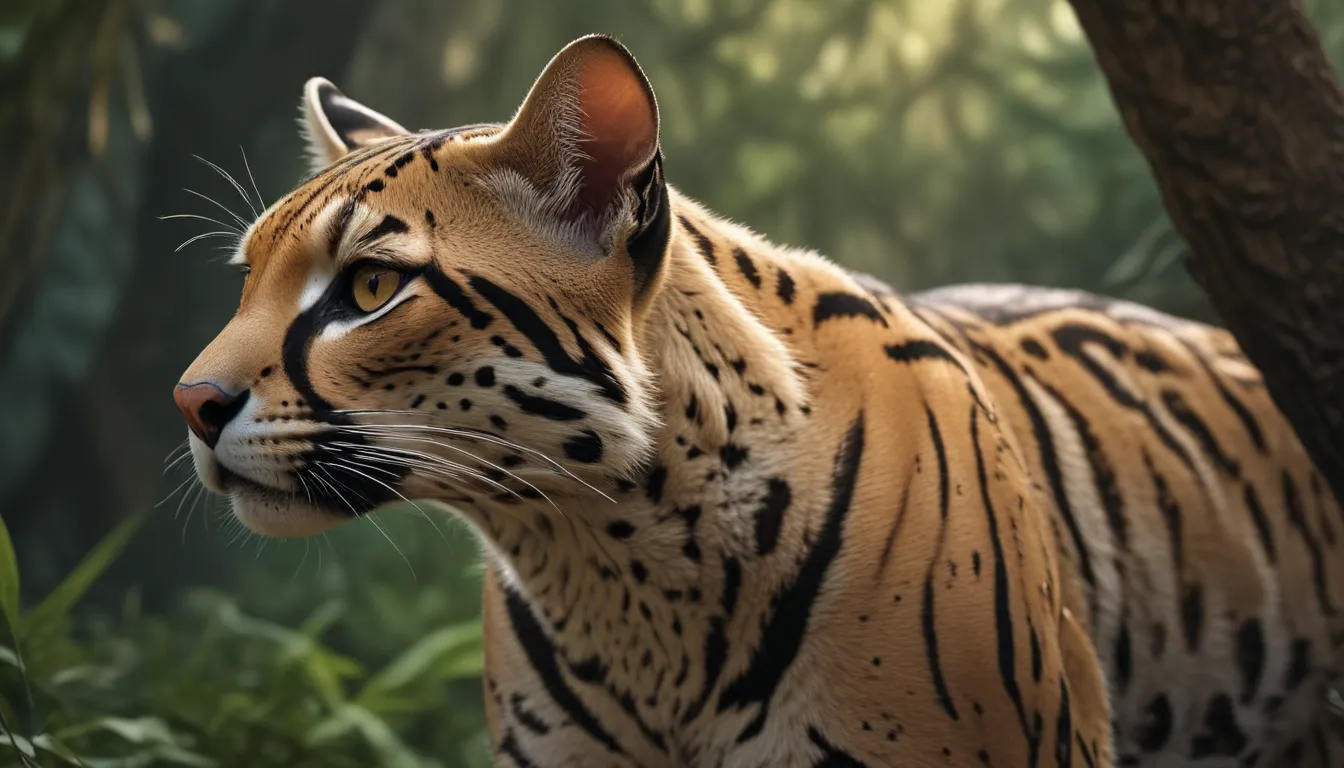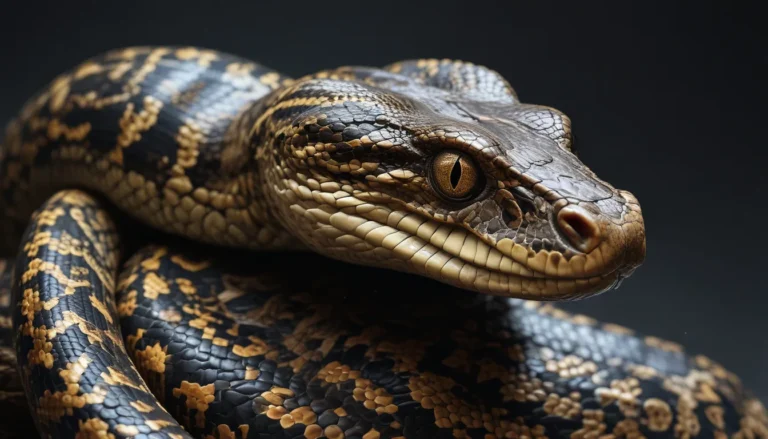The pictures we use in our articles might not show exactly what the words say. We choose these pictures to make you interested in reading more. The pictures work together with the words but don’t take their place. The words still tell you the important facts.
Welcome to the enchanting world of the ocelot, a mesmerizing feline predator that roams the dense rainforests of South America, Central America, and Mexico. With its striking appearance and elusive nature, the ocelot has captured the hearts of wildlife enthusiasts and animal lovers around the world. In this article, we will delve into 14 intriguing facts about the ocelot, shedding light on its physical characteristics, habitat, behavior, and more. Join us on a journey to uncover the mysteries behind one of the most remarkable creatures of the wild – the ocelot.
Unveiling the Mysteries of the Ocelot: 14 Fascinating Facts
The Ocelot’s Dazzling Spots: A Signature Feature
One cannot overlook the ocelot's distinctive coat, adorned with beautiful rosette-shaped spots. These spots serve as excellent camouflage, allowing the ocelot to blend seamlessly into its forested surroundings and stalk its prey undetected.
Masterful Tree Climbers: Agile and Nimble
Unlike many other big cats, ocelots are exceptional climbers. With sharp retractable claws and muscular limbs, they effortlessly ascend tall trees in search of prey, escape from predators, or seek refuge in the canopy.
Remarkable Night Vision: Hunting Under the Cover of Darkness
Ocelots are primarily nocturnal hunters, with eyes adapted to low-light conditions. Their keen night vision enables them to spot even the slightest movements in darkness, giving them a significant advantage during hunts.
A Diverse Diet: Opportunistic Predators
Ocelots have a varied diet, feeding on small mammals, birds, reptiles, and even fish. This adaptability allows them to thrive in different habitats, showcasing their versatility as predators.
Solitary Wanderers: Embracing Independence
Ocelots lead a solitary lifestyle, preferring to roam and hunt alone. They fiercely defend their large territories against intruders, signaling their presence through vocalizations and scent markings.
Territorial Guardians: Establishing Boundaries
Ocelots establish and maintain their territories through powerful scents and visual signals like scratch marks on trees. These territories can range from 3 to 45 square miles, depending on prey availability.
Aquatic Skills: Proficient Swimmers
In addition to their climbing prowess, ocelots excel in swimming. They navigate rivers, streams, and lagoons with ease, expanding their hunting territories and reaching new prey-rich areas.
Stealthy Hunters: Masters of Silent Movement
Ocelots move with remarkable stealth and silence when on the prowl. Their muscular bodies and adapted paws allow them to glide silently through dense vegetation, making them expert ambush predators.
Communicative Creatures: Vocalization for Connection
Communication is vital for ocelots to establish territories, attract mates, and signal danger. They produce a range of vocalizations, from low growls to purrs and chirps, each serving a specific purpose in their communication repertoire.
Broad Distribution: Roaming the Americas
Ocelots inhabit various habitats across Central and South America, from rainforests to marshlands and grasslands. Their distribution spans from Mexico to the United States in the north, down to Argentina and Uruguay in the south.
Conservation Concerns: Protecting a Precious Species
Despite their adaptability, ocelots face threats such as habitat loss, poaching, and illegal pet trade. Conservation efforts are crucial to safeguarding their populations and preserving their habitats for future generations.
Cultural Significance: Enchanting Across Generations
The mystique and allure of ocelots have captivated cultures throughout history. From ancient civilizations revering them as symbols of power to modern-day representations in artwork and literature, ocelots continue to fascinate and inspire.
Silent Sentinels: Guardians of the Wild
Ocelots fiercely guard their territories, which serve as essential hunting grounds, mating territories, and safe havens from predators. Their presence in ecosystems plays a vital role in maintaining the balance of nature.
Lifespan and Legacy: Adapting to the Changing World
In the wild, ocelots typically live for 10 to 13 years, while in captivity, they can thrive for up to 20 years. Understanding their behavior, habitat, and conservation needs emphasizes the importance of preserving biodiversity and protecting species like the ocelot.
Exploring the Enigmatic Ocelot: Embrace the Wonder of Wildlife
The captivating attributes of ocelots reveal them as truly extraordinary felines. Diving deeper into their world showcases more intricacies of these elusive wild cats. For those eager to learn more, embarking on a journey to uncover additional facts about ocelots provides a wealth of fascinating insights. Visit Amazon World Zoo Park for an opportunity to witness the incredible diversity of wildlife and their unique habitats.
Embrace Enlightening Exploration: Unveiling Nature’s Wonders
Our commitment to delivering trustworthy and engaging content underpins our dedication to authenticity and quality. Each fact shared on our platform comes from real users, ensuring a diverse range of insights and information. Trust in our rigorous editorial process to bring you the most accurate and fascinating content as you delve into the world of wildlife and exploration.
FAQs: Navigating the Realm of Ocelots
-
Q: Where can ocelots be found?
A: Ocelots inhabit various parts of South and Central America, including Mexico, Brazil, Argentina, and some regions of the United States. -
Q: What do ocelots eat?
A: Ocelots are carnivorous predators, feeding on small mammals, birds, reptiles, and fish. -
Q: Are ocelots endangered?
A: Ocelots are currently classified as a species of least concern by the IUCN, but they face threats such as habitat loss and illegal hunting. -
Q: How big do ocelots grow?
A: Ocelots are medium-sized cats, with males weighing between 20 to 35 pounds and females weighing between 15 to 25 pounds. -
Q: Can ocelots be kept as pets?
A: Ocelots are unsuitable as pets due to their wild instincts and specific habitat requirements, and it is illegal to keep them as pets in many countries. -
Q: Are ocelots solitary animals?
A: Yes, ocelots are predominantly solitary creatures with defined home ranges that they mark and defend. -
Q: What is the lifespan of an ocelot?
A: In the wild, ocelots typically live for around 10 to 13 years, while in captivity, they can live up to 20 years. -
Q: Can ocelots swim?
A: Yes, ocelots are adept swimmers, navigating across rivers and water bodies in search of prey or when migrating between habitats. -
Q: How do ocelots communicate?
A: Ocelots communicate through vocalizations, such as hisses, growls, meows, scent marking, and visual signals. -
Q: Do ocelots have predators?
A: Ocelots are apex predators in their habitats, with few animals preying on them. Larger predators like jaguars and pumas may occasionally target ocelots.
Explore the captivating world of ocelots, where their mystery and majesty intertwine to inspire awe and admiration. Discover the wonders of nature and the importance of conservation efforts in safeguarding the precious species that enrich our planet’s biodiversity. Join us in celebrating the enigmatic ocelot and the diverse wildlife that graces our world with its beauty and resilience.






